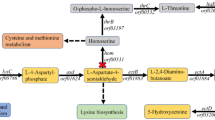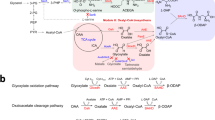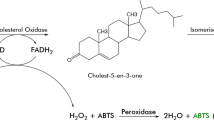Abstract
The function of hatomarubigin biosynthesis genes was analyzed by heterologous expression of the hrb gene cluster. Streptomyces lividans carrying a gene cluster consisting of 25 genes (hrbR1–hrbX) with hrbY was found to produce all the known hatomarubigins including hatomarubigin D, which has a unique dimeric angucycline with a methylene linkage. Gene disruption was used in this heterologous expression system to analyze the function of hrbF, a gene with no homology to any known angucycline biosynthesis genes. A new metabolite was detected in the fermented broth of S. lividans expressing the hrb genes lacking hrbF and was designated hatomarubigin F. This compound was identified as 5-hydroxyhatomarubigin E by NMR spectroscopic analysis, suggesting that HrbF regulates the regiospecificity of oxygenation enzymes.
Similar content being viewed by others
Introduction
Hatomarubigins A, B, C and D (Figure 1), multidrug-resistance reversal substances, were produced by Streptomyces sp. 2238-SVT4.1 Hatomarubigin E and rubiginone B2 were also found in the fermented broth as biosynthetic intermediates.2 These compounds belong to the angucycline family,3, 4 which is characterized by containing a modified benz[a]anthraquinone skeleton. Among them, hatomarubigin D was a unique dimeric angucycline with a methylene linkage. In our previous study,5 hatomarubigins except hatomarubigin D were produced by Streptomyces lividans carrying a gene cluster consisting of 25 genes (hrbR1–hrbX) to identify the hrb gene cluster (Figure 2) as hatomarubigin biosynthesis genes. Such a heterologous expression system is useful for functional analysis of unknown genes in the cluster. In this study, all the known hatomarubigins including hatomarubigin D were produced by heterologous expression of the 25 hrb genes with hrbY, and hatomarubigin F, a new member of the hatomarubigin family, was isolated from the fermented mycelium of S. lividans carrying the hrb cluster lacking hrbF.
Results and discussion
Expression of the hrb gene cluster including hrbY in S. lividans
Our previous study identified HrbY as an enzyme that can convert hatomarubigin C into hatomarubigin D in the presence of methylcobalamin.5 To confirm the in vivo function of HrbY, we constructed pWHM3-HR-Y, a plasmid carrying the 25 hrb genes (hrbR1–hrbX) with hrbY. All the known hatomarubigins including hatomarubigin D were detected by HPLC analysis of the fermented broth of S. lividans carrying pWHM3-HR-Y, although S. lividans expressing hrb genes without hrbY did not produce hatomarubigin D (Figure 3). These results demonstrated that HrbY is functional in vivo and the hatomarubigin biosynthesis gene cluster exists in the region from hrbR1 to hrbR3, a gene homologous to the angucycline biosynthesis regulator jadR1 (61% identity).5
HPLC analysis of the mycelial extract of S. lividans carrying pWHM3-HR5 (a); pWHM3-HR-Y (b); pWHM3-HR-YΔF (c) and pWHM3-HR-YΔF-F (d). 1: hatomarubigin F, 2: hatomarubigin B, 3: hatomarubigin A, 4: hatomarubigin C, 5: hatomarubigin E, 6: hatomarubigin D.
Expression of the hrb gene cluster lacking hrbF in S. lividans
The hrb gene cluster contains several genes with no homology to any known genes for angucycline biosynthesis (Figure 2). Among them, hrbF encodes a 234-amino-acid protein showing a weak similarity to antibiotic biosynthesis monooxygenase of S. griseus NBRC13350 SGR_5610 (34% identity) and ubiquinone/menaquinone biosynthesis methyltransferase of Caulobacter crescentus CB15 (34% identity). To investigate the function of hrbF, we constructed pWHM3-HR-YΔF, a plasmid that can express the hrb gene cluster lacking hrbF. The fermented mycelium of S. lividans carrying pWHM3-HR-YΔF contained all the hatomarubigins, thereby showing that hrbF is not essential for hatomarubigin biosynthesis. When the HPLC profiles were compared with those from S. lividans expressing the entire hrb gene cluster, a new metabolite was detected and the peak disappeared in the broth of the hrbF-reintroduced transformant (Figure 3). This substance was identified as a new member of the hatomarubigin family by spectroscopic analysis and designated hatomarubigin F (1).
Structure determination of hatomarubigin F (1)
The molecular formula of 1 was established as C19H16O6 by high-resolution EI-MS. The 13C- and 1H-NMR data summarized in Table 1 resembled those of hatomarubigin E.2 All one-bond 1H-13C connectivities were confirmed by an HMQC6 experiment. The COSY spectrum revealed a proton-spin network from a hydroxy proton (δ 4.96) through 1-H, 2-H2 and 3-H to 4-H2 and 3-CH3 (Figure 4). In the HMBC7 spectrum, a singlet aromatic proton at δ 7.58 displayed long-range correlations to four aromatic carbons (C-4a, C-5, C-6a and C-12a). Long-range couplings from both 1-H and 4-H (δ 2.16) to C-4a and C-12b (δC 146.8) constructed a tetrahydronaphthalene moiety. A quinone carbonyl (C-7) was attached to C-6a from a coupling between 6-H and C-7. HMBCs from ortho aromatic protons (δ 7.35 and 7.31) to four aromatic quaternary carbons including two oxygenated carbons (δC 155.9) required them to be in a 2,3-disubstituted hydroquinone ring (Figure 4). Downfield chemical shifts for the two phenolic hydroxy protons (δ 12.96 and 12.61) indicated a hydrogen-bonded arrangement of two quinone carbonyls to construct the 1,4-dihydroxyanthraquinone framework (Figure 4). The presence of a hydroxy group at C-5 was required by the molecular formula and the chemical shift of C-5 (δC 161.1), although the hydroxy proton was not observed. These results established the structure of hatomarubigin F (1) as 5-hydroxyhatomarubigin E.
Streptomyces sp. 2238-SVT4 produced rubiginone B2, which can be converted into hatomarubigins A and B by oxygenation at C-6 and C-11, respectively. In the hrb cluster, the two tandem genes hrbW and hrbX encoding oxidoreductase and oxygenase are considered to be involved in 11-hydroxylation.5 Putative oxygenase responsible for 6-hydroxylation is assignable to hrbG.5 Disruption of hrbF caused the oxygenation at an abnormal position C-5 and decreased production of hatomarubigin A (Figure 3), suggesting that HrbF controls regiospecificity of these oxygenating enzymes.
Experimental section
Bacterial strains and DNA manipulation
The media and growth conditions of Streptomyces sp. 2238-SVT4 and S. lividans TK23 were previously described.1, 5 Escherichia coli XL1-blue MRF’ and JM110 were grown in LB medium supplemented with 100 μg ml−1 ampicillin. KOD-plus DNA polymerase (Toyobo, Osaka, Japan) was used for PCR amplification following the manufacturer’s instructions. Other general procedures were performed as described by Sambrook et al.8
Construction of plasmids for expression of the hrb cluster
A 19.8-kbp fragment consisting of hrbR1 to hrbS (HR01) was constructed as previously described.5 A 5.2-kbp fragment consisting of hrbT to hrbX (HR02) was amplified from Streptomyces sp. 2238-SVT4 genomic DNA using primers with additional NsiI and NheI sites (5′-TGCATGCATGTGCGAGAGCGCTGGGACGCACGC-3′ and 5′-ACCGCTAGCTCAGACGGACAGCAGCCCGCGTGC-3′). A 1.1-kbp hrbY fragment (HR03) was amplified from the genomic DNA using primers with additional NheI and HindIII sites (5′-ACCGCTAGCATGAGTGCAACAGTCGCGGTCGTC-3′ and 5′-ACCAAGCTTTCAGCCGGCGGTGGGACCGAACTG-3′). XbaI/NsiI-digested HR01, NsiI/NheI-digested HR02, NheI/HindIII-digested HR03 and XbaI/HindIII-digested pWHM3 were ligated to construct pWHM3-HR-Y, a plasmid carrying hrbR1 to hrbX with hrbY. In this plasmid, hrbA to hrbY can be polycistronically transcribed.
Disruption of hrbF was carried out as described below. A 3.1-kbp NotI/PstI fragment containing hrbF was cloned into pBluescript II SK (+) (Agilent technologies, Santa Clara, CA,USA). A 1.2-kbp fragment upstream of hrbF was amplified from the plasmid using M13 primer RV and a primer with an additional BlnI site (5′-AACCTAGGCGTCTTTCACTCCCGGTGTCGTCG) and digested with NotI and BlnI. A 1.2-kbp fragment downstream of hrbF was amplified using M13 primer M4 and a primer with an additional BlnI site (5′-AGCCTAGGGCGCGCAGGTCGGCCCCAGAAGGA-3′) and digested with PstI and BlnI. These two fragments were ligated to NotI/PstI digested pBluescript II SK (+). A hrbF-deleted 2.4-kbp fragment obtained by NotI/PstI digestion of the plasmid was swapped with an original 3.1-kbp NotI/PstI fragment of pWHM3-HR-Y to construct pWHM3-HR-YΔF. A 0.7-kbp hrbF fragment was amplified from the genomic DNA using primers with additional BlnI sites (5′-GACCTAGGATGCCTGTAGCCTCCGACGCCCCA-3′ and 5′-CGCCTAGGTCAGTCGGCTGTCTTCTCCAGCGC-3′) and reintroduced into an artificial BlnI site between hrbE and hrbG of pWHM3-HR-YΔF in the same orientation to construct pWHM3-HR-YΔF-F for complementary analysis of hrbF.
Heterologous expression of hatomarubigin biosynthesis genes
The expression plasmids passaged through E. coli JM110 were introduced into S. lividans TK23. The transformants were inoculated into a seed medium consisting of 10.3% sucrose, 3.0% glucose, 1.5% Bacto Soytone, 0.1% glycine, 3 mM CaCl2, 5 mM MgCl2 and 10 μg ml−1 thiostrepton (pH 7.2). After incubating on a reciprocal shaker at 27 °C, 2 ml of the seed culture was transferred into 500-ml baffled Erlenmeyer flasks containing 50 ml of a production medium consisting of 2.5% soluble starch, 1.5% soybean meal, 0.2% dry yeast, 0.4% CaCO3 and 10 μg ml−1 thiostrepton (pH 6.2). The fermentation was carried out on a rotary shaker at 27 °C for 2–3 days. The fermentation broth was centrifuged, and the mycelium was extracted with acetone. After evaporation, the aqueous concentrate was extracted with ethyl acetate. The extract was analyzed by reversed-phase HPLC (YMC-Pack R-ODS-7, 4.6 mm id × 250 mm; YMC, Kyoto, Japan) with 80% methanol. Absorption peaks for the hatomarubigins were detected at 470 nm.
Isolation of hatomarubigin F (1)
The mycelium was obtained by centrifugation of the 2-day fermented broth (5 liters) of S. lividans TK23 carrying pWHM3-HR-YΔF and extracted with acetone. The extract was concentrated and partitioned between ethyl acetate and water. The organic layer was evaporated and dissolved in chloroform. The precipitate by addition of 10 volumes of hexane was dissolved in methanol and filtered. The filtrate was subjected to HPLC (YMC-Pack D-ODS-7, 20 mm id × 250 mm; YMC) with 80% methanol–0.2% phosphoric acid. One of the major peaks (retention volume: 280 ml) was further purified by HPLC (YMC-Pack D-ODS-7) with 75% methanol containing 5 mM disodium hydrogen citrate. The main fraction (retention volume: 395 ml) was evaporated and the aqueous concentrate was extracted with ethyl acetate. The extract was washed with water and concentrated to dryness to give an orange powder of 1 (1.2 mg).
Physico-chemical properties of hatomarubigin F (1)
m.p. 276–278 °C; high-resolution EI-MS m/z 340.0948 (M+, calcd for C19H16O6, 340.0947); UV λmax (ɛ) 224 nm (20 300), 287 nm (18 000), 475 nm (6800) in methanol, 226 nm (22 000), 287 nm (20 000), 474 nm (7000) in 0.01 M HCl-methanol, 240 nm (14 200), 310 nm (15 000), 534 nm (8300) in 0.01 M NaOH-methanol; IR (ATR) νmax 3438, 3127, 1619, 1568, 1449, 794 cm−1.
Spectroscopic measurements
Mass spectra were obtained on a JMS-SX102A spectrometer (JEOL Ltd., Tokyo, Japan) in the EI mode. UV and IR spectra were measured on Shimadzu UV-1700 and JASCO FT/IR-410 spectrometers, respectively. NMR spectra were obtained in DMSO-d6 on a JEOL JNM-LA400 spectrometer with 1H-NMR at 400 MHz and with 13C-NMR at 100 MHz. Chemical shifts are given in p.p.m. relative to DMSO at 2.49 p.p.m. for 1H-NMR and at 39.5 p.p.m. for 13C-NMR.
References
Hayakawa, Y., Ha, S.-C., Kim, Y. J., Furihata, K. & Seto, H. Studies on the isotetracenone antibiotics. IV Hatomarubigins A, B, C and D, new isotetracenone antibiotics effective against multidrug-resistant tumor cells. J. Antibiot. 44, 1179–1186 (1991).
Kawasaki, T., Yamada, Y., Maruta, T., Maeda, A. & Hayakawa, Y. Hatomarubigin E, a biosynthetic intermediate of hatomarubigins C and a substrate of HrbU O-methyltransferase. J. Antibiot. 63, 725–727 (2010).
Krohn, K. & Rohr, J. Angucyclines: total syntheses, new structures, and biosynthetic studies of an emerging new class of antibiotics. Top. Curr. Chem. 188, 127–195 (1997).
Rohr, J. & Thiericke, R. Angucycline group antibiotics. Nat. Prod. Rep. 9, 103–137 (1992).
Kawasaki, T. et al. Cloning and characterization of a gene cluster for hatomarubigin biosynthesis in Streptomyces sp. strain 2238-SVT4. Appl. Environ. Microbiol. 76, 4201–4206 (2010).
Summers, M. F., Marzilli, L. G. & Bax, A. Complete 1H and 13C assignments of coenzyme B12 through the use of new two-dimensional NMR experiments. J. Am. Chem. Soc. 108, 4285–4294 (1986).
Bax, A. & Summers, M. F. 1H and 13C assignments from sensitivity enhanced detection of heteronuclear multiple-band connectivity by multiple quantum NMR. J. Am. Chem. Soc. 108, 2093–2094 (1986).
Sambrook, J. & Russell, D. W. Molecular cloning: A Laboratory Manual pp 1.1–1.162 Cold Spring Harbor Laboratory: Cold Spring Harbor, New York, (2001).
Acknowledgements
This work was supported in part by a Grant-in-Aid for Scientific Research (C), The Ministry of Education, Science, Sports and Culture, Japan. We thank Dr T Dairi, Hokkaido University, for the generous gift of plasmids and E. coli strains. We thank F Hasegawa, Tokyo University of Science, for assistance with mass spectrometry.
Author information
Authors and Affiliations
Corresponding author
Rights and permissions
About this article
Cite this article
Izawa, M., Kimata, S., Maeda, A. et al. Functional analysis of hatomarubigin biosynthesis genes and production of a new hatomarubigin using a heterologous expression system. J Antibiot 67, 159–162 (2014). https://doi.org/10.1038/ja.2013.96
Received:
Revised:
Accepted:
Published:
Issue Date:
DOI: https://doi.org/10.1038/ja.2013.96
Keywords
This article is cited by
-
Unravelling key enzymatic steps in C-ring cleavage during angucycline biosynthesis
Communications Chemistry (2023)







